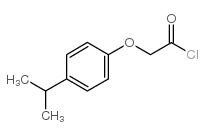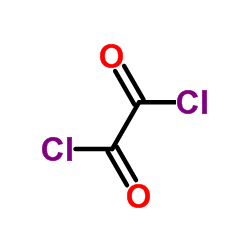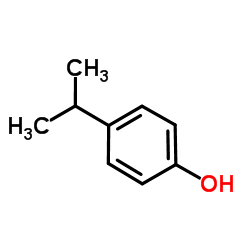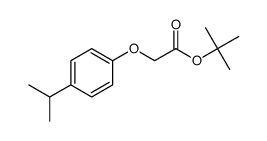223128-33-4
| Name | 2-(4-propan-2-ylphenoxy)acetyl chloride |
|---|---|
| Synonyms |
p-isopropylphenoxyacetyl chloride
isopropylphenoxyacetyl chloride 2-(4-isopropylphenoxy)acetyl chloride (4-ISOPROPYLPHENOXY)ACETYL CHLORIDE MFCD02628421 F2190-0105 4-Isopropylphenoxyacetyl chloride 4-Isopropyl Phenoxy Acetyl Chloride |
| Density | 1.128g/cm3 |
|---|---|
| Boiling Point | 276.8ºC at 760mmHg |
| Molecular Formula | C11H13ClO2 |
| Molecular Weight | 212.67300 |
| Flash Point | 103.2ºC |
| Exact Mass | 212.06000 |
| PSA | 26.30000 |
| LogP | 2.95420 |
| Vapour Pressure | 0.00469mmHg at 25°C |
| Index of Refraction | 1.512 |
| Water Solubility | Very slightly soluble (0.23 g/L) (25 ºC) |
Synonym: Section 2 - COMPOSITION, INFORMATION ON INGREDIENTS
Risk Phrases: 29 34 Section 3 - HAZARDS IDENTIFICATION EMERGENCY OVERVIEW
Contact with water liberates toxic gas. Causes burns. Potential Health Effects Eye: Causes eye burns. Lachrymator (substance which increases the flow of tears). Skin: Causes skin burns. Ingestion: Causes gastrointestinal tract burns. Inhalation: Causes chemical burns to the respiratory tract. Chronic: Not available. Section 4 - FIRST AID MEASURES Eyes: Immediately flush eyes with plenty of water for at least 15 minutes, occasionally lifting the upper and lower eyelids. Get medical aid immediately. Skin: Get medical aid immediately. Immediately flush skin with plenty of water for at least 15 minutes while removing contaminated clothing and shoes. Ingestion: Do not induce vomiting. Get medical aid immediately. Inhalation: Get medical aid immediately. Remove from exposure and move to fresh air immediately. If not breathing, give artificial respiration. If breathing is difficult, give oxygen. Notes to Physician: Treat symptomatically and supportively. Section 5 - FIRE FIGHTING MEASURES General Information: As in any fire, wear a self-contained breathing apparatus in pressure-demand, MSHA/NIOSH (approved or equivalent), and full protective gear. Water Reactive. Material will react with water and may release a flammable and/or toxic gas. Extinguishing Media: Use foam, dry chemical, or carbon dioxide. DO NOT USE WATER! Section 6 - ACCIDENTAL RELEASE MEASURES General Information: Use proper personal protective equipment as indicated in Section 8. Spills/Leaks: Absorb spill with inert material (e.g. vermiculite, sand or earth), then place in suitable container. Section 7 - HANDLING and STORAGE Handling: Do not breathe dust, vapor, mist, or gas. Do not get in eyes, on skin, or on clothing. Use only in a chemical fume hood. Storage: Store in a cool, dry place. Store in a tightly closed container. Corrosives area. Section 8 - EXPOSURE CONTROLS, PERSONAL PROTECTION Engineering Controls: Facilities storing or utilizing this material should be equipped with an eyewash facility and a safety shower. Use adequate ventilation to keep airborne concentrations low. Exposure Limits CAS# 223128-33-4: Personal Protective Equipment Eyes: Not available. Skin: Wear appropriate protective gloves to prevent skin exposure. Clothing: Wear appropriate protective clothing to prevent skin exposure. Respirators: Follow the OSHA respirator regulations found in 29 CFR 1910.134 or European Standard EN 149. Use a NIOSH/MSHA or European Standard EN 149 approved respirator if exposure limits are exceeded or if irritation or other symptoms are experienced. Section 9 - PHYSICAL AND CHEMICAL PROPERTIES Physical State: Liquid Color: Not available. Odor: Not available. pH: Not available. Vapor Pressure: Not available. Viscosity: Not available. Boiling Point: Not available. Freezing/Melting Point: Not available. Autoignition Temperature: Not available. Flash Point: Not available. Explosion Limits, lower: Not available. Explosion Limits, upper: Not available. Decomposition Temperature: Solubility in water: Specific Gravity/Density: Molecular Formula: C11H14ClO2 Molecular Weight: 213.68 Section 10 - STABILITY AND REACTIVITY Chemical Stability: Moisture sensitive. Conditions to Avoid: Incompatible materials, exposure to moist air or water. Incompatibilities with Other Materials: Oxidizing agents, strong bases, alcohols. Hazardous Decomposition Products: Hydrogen chloride, carbon monoxide, carbon dioxide, phosgene gas. Hazardous Polymerization: Has not been reported Section 11 - TOXICOLOGICAL INFORMATION RTECS#: CAS# 223128-33-4 unlisted. LD50/LC50: Not available. Carcinogenicity: 4-Isopropylphenoxyacetyl chloride - Not listed by ACGIH, IARC, or NTP. Section 12 - ECOLOGICAL INFORMATION Section 13 - DISPOSAL CONSIDERATIONS Dispose of in a manner consistent with federal, state, and local regulations. Section 14 - TRANSPORT INFORMATION IATA Shipping Name: CORROSIVE LIQUID, ACIDIC, ORGANIC, N.O.S.* Hazard Class: 8 UN Number: 3265 Packing Group: II IMO Shipping Name: CORROSIVE LIQUID, ACIDIC, ORGANIC, N.O.S. Hazard Class: 8 UN Number: 3265 Packing Group: II RID/ADR Shipping Name: CORROSIVE LIQUID, ACIDIC, ORGANIC, N.O.S. Hazard Class: 8 UN Number: 3265 Packing group: II Section 15 - REGULATORY INFORMATION European/International Regulations European Labeling in Accordance with EC Directives Hazard Symbols: C Risk Phrases: R 29 Contact with water liberates toxic gas. R 34 Causes burns. Safety Phrases: S 26 In case of contact with eyes, rinse immediately with plenty of water and seek medical advice. S 36/37/39 Wear suitable protective clothing, gloves and eye/face protection. S 45 In case of accident or if you feel unwell, seek medical advice immediately (show the label where possible). WGK (Water Danger/Protection) CAS# 223128-33-4: No information available. Canada None of the chemicals in this product are listed on the DSL/NDSL list. CAS# 223128-33-4 is not listed on Canada's Ingredient Disclosure List. US FEDERAL TSCA CAS# 223128-33-4 is not listed on the TSCA inventory. It is for research and development use only. SECTION 16 - ADDITIONAL INFORMATION N/A |
| Hazard Codes | C |
|---|---|
| RIDADR | UN3265 |
| Packaging Group | II |
| Hazard Class | 8 |
| HS Code | 2918990090 |
|
~92% 
223128-33-4 |
| Literature: Ozcan, Sevil; Kazi, Aslamuzzaman; Marsilio, Frank; Fang, Bin; Guida, Wayne C.; Koomen, John; Lawrence, Harshani R.; Sebti, Said M. Journal of Medicinal Chemistry, 2013 , vol. 56, # 10 p. 3783 - 3805 |
|
~%
Detail
|
| Literature: US6528525 B1, ; |
|
~% 
223128-33-4 |
| Literature: Journal of Medicinal Chemistry, , vol. 56, # 10 p. 3783 - 3805 |
|
~% 
223128-33-4 |
| Literature: Journal of Medicinal Chemistry, , vol. 56, # 10 p. 3783 - 3805 |
| Precursor 4 | |
|---|---|
| DownStream 0 | |
| HS Code | 2918990090 |
|---|---|
| Summary | 2918990090. other carboxylic acids with additional oxygen function and their anhydrides, halides, peroxides and peroxyacids; their halogenated, sulphonated, nitrated or nitrosated derivatives. VAT:17.0%. Tax rebate rate:13.0%. . MFN tariff:6.5%. General tariff:30.0% |





